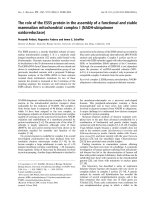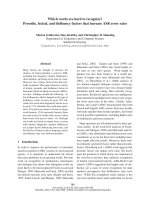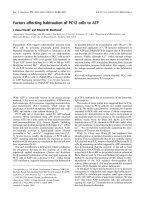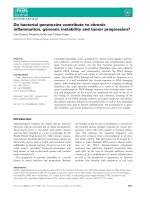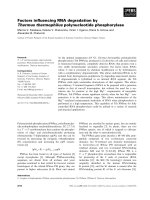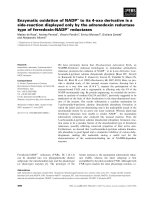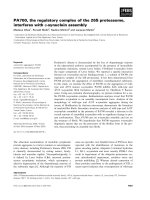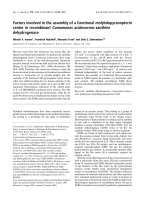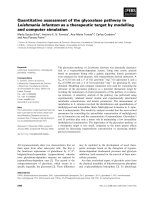báo cáo khoa học: " Factors influencing patient willingness to participate in genetic research after a myocardial infarction" pptx
Bạn đang xem bản rút gọn của tài liệu. Xem và tải ngay bản đầy đủ của tài liệu tại đây (290.01 KB, 8 trang )
RESEARC H Open Access
Factors influencing patient willingness to
participate in genetic research after
a myocardial infarction
David E Lanfear
1*
, Philip G Jones
2
, Sharon Cresci
3
, Fengming Tang
2
, Saif S Rathore
4
and John A Spertus
2
Abstract
Background: Achieving ‘personalized medicine’ requires enrolling representative cohorts into genetic studies, but
patient self-selection may introduce bias. We sought to identify characteristics associated with genetic consent in a
myocardial infarction (MI) registry.
Methods: We assessed correlates of participation in the genetic sub-study of TRIUMPH, a prospective MI registry (n
= 4,340) from 24 US hospitals between April 2005 and December 2008. Factors examined included extensive socio-
demographics factors, clinical variables, and study site. Predictors of consent were identified using hierarchical
modified Poisson regression, adjusting for study site. Variation in consent rates across hospitals were quantified by
the median rate ratio (MRR).
Results: Most subjects consented to donation of their genetic material (n = 3,484; 80%). Participation rates varied
greatly between sites, from 40% to 100%. After adjustment for confounding factors, the MRR for hospital was 1.22
(95% confidence interval (CI) 1.11 to 1.29). The only patient-level factors associated with consent were race (RR 0.93
for African Americans versus whites, 95% CI 0.88 to 0.99) and body mass in dex (RR 1.03 for BMI ≥ 25, 95% CI 1.01
to 1.06).
Conclusion: Among patients with an MI there were notable differences in genetic consent by study site, but little
association with patient-level factors. This suggests that variation in the way information is presented during
recruitment, or other site factors, strongly influence patients’ decision to participate in genetic studies.
Background
As genetic research becomes more common and genetic
factors are studied as a means for improving risk stratifi-
cation and t reatment, it is essential that participating
subjects are representative of the general population of
patients from which they are recruited. However, genetic
research often a ttains lower partici pation rates com-
pared with non-genetic studies [1]. Failure to recruit eli-
gible subjects may also introduce selection biases into
genetic studies, potentially jeopardizing both internal
and external validity. Existing studies addressing this
issue have revealed participation rates for genetic studies
ranging from 21% to 99% [2-5]. This variability depends
on many factors, including the disease under study [6],
circumstances in which the patient is recruited [5], as
well as a variety of patient characteristics that may
impact patients’ willingness to participate, including race
[7,8], education [9,10], and gender [3,7,8,11].
The existing literature has limited data regarding the
genetic participation of patients with acute illnesses,
which are required to study common cardiovascular dis-
eases such as myocardial infarction (MI). First, some of
the larger published studies are based upon opinion sur-
veys (that is, asking whether the subject would be will-
ing to participate in a theoretical genetic study)
[2,10,12]. While these are important to help illuminate
subjects’ decision-making processes, subjects considering
actual sample donation may behave differently when
faced with the reality of under going blood/tissue collec-
tion, the potential risk of a confidentiality breach, or
other real or perceived consequences of genetic analyses.
Among studies that did involve actual donation and
* Correspondence:
1
Henry Ford Hospital, Heart and Vascular Institute, Detroit, Michigan, 48202,
USA
Full list of author information is available at the end of the article
Lanfear et al . Genome Medicine 2011, 3:39
/>© 2011 Lanfear et al.; licensee BioMed Central Ltd This is an open access article distributed under the terms of the Creative Commons
Attribution License ( which permits unrestricted use, distribution, and reproduction in
any medium, provided the original work is properly cited.
storage of samples, few have included large numbers of
patients enrolled during the course of acute illness,
which may also affect participation rates. For example,
dissimilar pa rticipation rates have been reported for
population-based studies compared to hospital-based
cohorts [5]. Further clouding the literature is that most
genetic studies have not ade quately described popula-
tions fro m which samples were recruited, precluding an
assessment of participation bias and potentially affecting
internal and external validity [5]. The only study we are
aware of examining genetic participation rates in an MI
registry found significant clinical differences between
participants and non-participa nts [13], calling in to ques-
tion the external validity of this study. A better under-
standing of the variability in patients’ willingness t o
participate in genetic studies of acute cardiovascular dis-
ease is needed to assess for selection biases and to iden-
tify opportunit ies to improve participation and optimize
the generalizability of such studies.
To address this existing knowledge gap, we examined
characteristics associated w ith participation in a genetic
sub-study within a large multi-center registry of MI
patients. TRIUMPH (Translational Research Investigat-
ing disparities in Myocardial infarction Patients’ Health
status) is a multi-center study of MI patients at 24 US
centers spread across the country and representing
urban, suburban, academic, and community hospitals. A
principal goal of this study was to assess genetic and
pharmacogenomic factors associated with post-MI out-
comes. Each enrolled patient was invited, but not
required, t o contribute DNA for genetic study. Partici-
pating hospitals were from diverse regions, including
academic and community centers, a broad spectrum of
economic and racial populations, as well as urban and
rural locations. As such, TRIUMPH provided an ideal
opportunity to examine patient factors associated with
participation in genetic studies. Specifically, we sought
to identify factors associated with genetic study partici-
pation, and to examine a ny differences between partici-
pants and those who chose not to donate their genetic
material, in the hopes that these insights could improve
recruitment in future studies.
Materials and met hods
Participants
All data and analyses presented here are part of the
TRIUMPH study, a prospective registry of patients with
acute MI from 24 hospitals across the United States
(listed in Acknowledgements). The study was Institu-
tional Review Board approved a t all participating sites,
and written informed consent was obtained from all
participants. All patients who entered the registry were
also offered participation in the genetic sub-study; how-
ever, this was not mandatory (that is, patients could
participate in the registry without contributing DNA). A
Federal Certificate of Confidentiality was obtained to
further protect the confidentiality of patients’ informa-
tion and this was disclosed to patients in the informed
consent document. Patients were enrolled from April
2005 to December 2008.
Data collection
For each patient in the parent study, detailed clinical
and treatment characteristics were collected by chart
abstraction and interview. Trained data collectors at
each site participated in the acquisition of requisite data.
Factors examined for association with genetic study par-
ticipation included the socio-demographic, financial,
social support, medical literacy, health status, depressive
symptoms, clinical variables listed in Table 1 and enroll-
ment site. All psychosocial and health status characteris-
tics were quantified using standardized instruments, as
previously described for the PREMIER study [14].
All study staff underwent similar training at in-person
meetings. Ongoing data collection issues were addressed
through monthly conference calls. There were similar
staffing ratios (per-recruited patient) across sites. Tem-
plates for informed consent documents and educational
pamphlets about th e study were provided and used or
modified by each site.
Statistical analyses
Patient s were divided into two groups based on whether
they consented to donate their genetic material (DNA)
for storage and study, or not. Patient characteristics
were compared using Chi-square tests for categorical
variables and t-tests for continuous ones. The likelihood
of consent was modeled using hierarchical regression
that included a random e ffect for hospital. Because the
consent rate was high, we estimated rate ratios (RRs)
directly (that is, instead of estimating odds ratios) by
using a modified Poisson regression model with robust
standar d errors [15]. For multivari able models, we i niti-
ally included characteristics thought a priori to be asso-
ciated with participating in the genetic sub-study. T hese
included age, race, gender, education, finances, social
support, symptom severity, and hospital. In order to
assess for potentially important patient characteristics,
we also included the characteristics from Table 1 that
showed univariate association w ith participation (P <
0.05) in the multivariable models. Variation in consent
rates between hospitals was quantified by the median
rate ratio (MRR), which estimates the average relative
difference in likelihood of two hypothetical patients,
with identical covariates, consenting if enrolled at two
different hospitals. Site participation rates are shown as
smoothed estimates, which are a weighted average of
the hospital’s individual rate and the overall rate for the
Lanfear et al . Genome Medicine 2011, 3:39
/>Page 2 of 8
Table 1 Patient characteristics in genetic sub-study participants versus non-participants
Consented to use of DNA
Yes (n = 3,484) No (n = 856) P-value
Demographics
Age 58.9 ± 12.2 59.8 ± 12.7 0.038
White/Caucasian race 2,342 (67.4%) 573 (67.3%) 0.981
Male 2,347 (67.4%) 551 (64.4) 0.095
Language 0.293
English 3,353 (98.4%) 823 (97.9%)
Spanish 55 (1.6%) 18 (2.1%)
Missing 76 15
Ethnicity 0.870
Hispanic/latino 217 (6.4%) 54 (6.6%)
Non-hispanic/latino 3,175 (93.6%) 770 (93.4%)
Unknown 92 32
Low social support 612 (18.3%) 109 (13.1%) < 0.001
Missing 133 23
REALM-R score ≤ 6 844 (28.5%) 170 (28.1%) 0.823
NA, missing, or unknown 423 250
Socio-economic status
Completed high school 2,764 (79.8%) 656 (76.9%) 0.058
History of avoiding medical care due to cost 904 (26.5%) 184 (21.7%) 0.004
End-of-month financial situation <0.001
Some money left over 1,380 (40.4%) 397 (47.3%)
Just enough to make ends meet 1,297 (37.9%) 295 (35.1%)
Not enough to make ends meet 741 (21.7%) 148 (17.6%)
Medical history
BMI 29.8 ± 10.2 29.0 ± 6.5 0.025
Chronic heart failure 302 (8.7%) 70 (8.2%) 0.646
Dyslipidemia 1,721 (49.4%) 407 (47.5%) 0.332
Hypertension 2,318 (66.5%) 575 (67.2%) 0.722
Prior MI 710 (20.4%) 202 (23.6%) 0.038
Cancer 250 (7.2%) 62 (7.2%) 0.946
Diabetes 1,068 (30.7%) 268 (31.3%) 0.710
Presentation
Final MI diagnosis 0.568
STEMI 1,475 (42.3%) 383 (44.7%)
NSTEMI 1,979 (56.8%) 465 (54.3%)
BBB/uncertain type 7 (0.2%) 2 (0.2%)
Patient not diagnosed with MI 23 (0.7%) 6 (0.7%)
Peak troponin 29.3 ± 76.6 25.6 ± 58.1 0.187
Medications (arrival and discharge)
Aspirin on arrival 1,431 (41.1%) 353 (41.2%) 0.930
Beta blocker at DC 3,109 (89.7%) 776 (91.4%) 0.132
Thienopyridine on Arrival 433 (12.4%) 113 (13.2%) 0.541
Statin at DC 3,030 (87.4%) 744 (87.6%) 0.852
Lanfear et al . Genome Medicine 2011, 3:39
/>Page 3 of 8
entire cohort, where the weight given to an individual
hospital is roughly proportional to their sample size.
Smoothing was used in order to take into account the
fact that some hospitals have small sample sizes and
thus more uncertainty around their true rate.
Approximately 16.1% of patients had missing covariate
data (13.8% were missing one value, 1.8% were missing
two values, and 0.5% were missing three or more val ues;
the highest missing rate for any single variable (Patient
Health Questionnaire (PHQ) depression score) was
6.4%. Missing covariate data were imputed with multiple
imputation using IVEwareE [16]. A ll analyses were per-
formed in SAS version 9.1.3 (SAS Institute, Cary, North
Carolina, USA), and R, version 2.7.0 (Foundation for
Statistical Computing, Vienna, Austria).
Results
A total of 4,340 patients were enrolled in the study. Of
these, 3,484 (80%) consented to donate their DNA for
study. Clinical and socio-demographic characteristics
among genetic sub-study participants versus non-partici-
pants a re summarized in Table 1. Several socio-demo-
graphic factors di ffered between participants a nd non-
participants in unadjusted analyses, including measures
of social suppor t, literacy, education, financial hardship,
and smoking status. Among clinical variables, health
status, body mass index (BMI), history of MI, history of
stroke, and receiving beta-blockers on arrival each had
univariate associations with genetic consent. The genetic
participation rate varied across enrolling sites, ranging
from 40% to 100%. Smoothed estimates of site participa-
tion rates derived from the random effects model are
shown in Figure 1.
A multivariable modified Poisson model was then
constructed to test for factors associated with consent-
ing t o genetic testing (Figure 2). The only factors inde-
pendently associated with participation were African
American race, enrollment site, and BMI. African Amer-
ican race was associated with a 7% lower rate of con-
senting to genetic study c ompared with white patients
(RR 0.93; 95% confidence interval (CI) 0.88 to 0.99).
Higher BMI (≥ 25) was marginally associated with a
slightly higher participation with RR of 1.03 (95% CI
1.01 to 1.06). Several other factors were of borderline
significance, including PHQ-9 score (RR 1.02 for every 5
points; 95% CI 1.00 to 1.05) and chronic lung disease
(RR 1.04; 95% CI 1.00 to 1.08). By far, the strongest fac-
tor associated with participating in the genetic study
was enrollment site. The MRR was 1.22 (95% CI 1.11 to
1.29), suggesting that an identical patient presenting at
onehospitalwould,onaverage,haveanearly1in4
greater likelihood of participating in a genetic study
Table 1 Patient characteristics in genetic sub-study participants versus non-participants (Continued)
Processes of care
In-hospital cardiac catheterization 3,222 (92.5%) 777 (90.8%) 0.096
In-hospital revascularization 2,498 (71.7%) 618 (72.2%) 0.772
Enrolled in other study 326 (9.4%) 70 (8.2%) 0.283
Length of stay 5.6 ± 6.4 6.0 ± 8.90 0.207
Health Status
SAQ Quality of Life score 62.2 ± 23.6 67.5 ± 23.3 < 0.001
SAQ Angina Stability score 43.8 ± 21.8 47.1 ± 20.6 < 0.001
SAQ Physical Limitation score 85.0 ± 22.6 88.4 ± 19.6 < 0.001
SF-12v2 Mental Component score 49.6 ± 11.5 50.0 ± 11.6 0.411
SF-12v2 Physical Component score 42.0 ± 12.4 42.8 ± 12.5 0.094
PHQ-9 depression severity <0.001
Not clinically depressed 1,763 (54.4%) 539 (65.7%)
Mild depression 831 (25.6%) 170 (20.7%)
Moderate depression 376 (11.6%) 72 (8.8%)
Moderately severe depression 191 (5.9%) 27 (3.3%)
Severe depression 81 (2.5%) 12 (1.5%)
Missing 242 36
GRACE 6 m Mortality Risk score 100.0 ± 29.81 103.0 ± 31.1 0.008
Baseline patient characteristics are listed in the left-most column, with the quantities for those that participated in the genetic study, those that did not, and the
P-value for difference between the two in the subsequent three columns. Categorical variables are shown as the number of subjects with that characteristic,
followed by the proportion this represents (percentage) in parentheses. For variables that have subcategories, each subcategory and the number and proportion
of subjects in that group is shown. Continuous variables are shown as the mean ± the standard deviation. Categorical variables were compared using chi-square
or Fisher’s exact test. Continuous variables were compared using Student’ s t-test. BBB, bundle branch block; BMI, body mass index; DC,; GRACE, Global Registry of
Acute Coronary Events; NA, not applicable; NSTEMI, non-ST elevation myocardial infarction; PHQ, Patient Health Questionnaire; SAQ, Seattle Angina Questionaire;
SF, Short Form; STEMI, ST elevation myocardial infarction.
Lanfear et al . Genome Medicine 2011, 3:39
/>Page 4 of 8
than if that same patient had presented to a different
TRIUMPH hospital.
Discussion
We sought to define characteristics associated with par-
ticipation in a genetic sub-study of a large acute MI reg-
istry. We found that the vast majority of patients chose
to participate in genetic testing (around 80%), with few
differences between those who did and did not agree to
donate DNA. Although we found race to be mildly asso-
ciated with patient s’ willingness to participate in genetic
studies, other factors such as gender and education level
were not. Most importantly, the strongest predictor of
participation in the genetic sub-study was hospital site,
with wide variability seen in rates across sites.
Reduced genetic participation among racial minorities
is a particularly critical issue since racial disparities in
health outcomes are high-priority research topics, and
the genetic versus non- genetic components of health
disparities need to be better elucidated. Higher rates of
participation in ge netic studies among white patients, as
compared with African Americans, have been previously
described [4,7,8]. A lower likelihood of African
American participation in medical research generally
has also been well described, with lack of trust or confi-
dence in the researchers being one important factor
[17]. Similarly, trust is one of the most of ten cited med-
iating factors for participation in genetic studies [2], and
this is also the case in studies specifically focusing upon
racial differences in genetic research; patient concerns
about confidentiali ty were a consistent reason for choos-
ing not to participate [12,18]. In our study, African
Americans were 7% less likely to participate than whites,
a modest difference in participation rates. While further
qualitative s tudies may help illuminate the mechanism,
awareness of this poten tial selection bias is important
during study enrollment so that under-representation of
racial minorities can be minimized. Making every effort
to establish trust and rapport with subjects, as well as
confidence in the research team and their confidentiality
protections, may help reduce refusal rates.
To our knowledge, the association of genetic consent
with BMI has not been previously reported, and the
magnitude of the association is of questionable clinical
significance. Given the number of possible predictors
included in this study, this association m ay be spurious.
0 0.2 0.4 0.6 0.8 1
Hospital X
Hospital W
Hospital V
Hospital U
Hospital T
Hospital S
Hospital R
Hospital Q
Hospital P
Hospital O
Hospital N
Hospital M
Hospital L
Hospital K
Hospital J
Hospital I
Hospital H
Hospital G
Hospital F
Hospital E
Hospital D
Hospital C
Hospital B
Hospital A
(n=320)
(n=88)
(n=69)
(n=822)
(n=181)
(n=19)
(n=73)
(n=74)
(n=139)
(n=56)
(n=135)
(n=60)
(n=36)
(n=181)
(n=318)
(n=504)
(n=189)
(n=171)
(n=505)
(n=46)
(n=135)
(n=44)
(n=15)
(n=160)
Figure 1 Genetic consent rates by hospital.EachhospitalislabeledbylettersAtoH(verticalaxis).Eachdotandlinerepresentsthe
proportion of subjects at the site that consented to genetic sub-study enrollment. The central dot shows the point estimate of the site rate
(percentage) generated from the random effects models. The lines extending from the dot represent the 95% confidence interval.
Lanfear et al . Genome Medicine 2011, 3:39
/>Page 5 of 8
Confirmation of this finding in an independent cohort is
needed and, if consistent findings are observed, then
qualitative research could be used to better understand
the potential mechanism of this association. In contrast
to previous studies, our data d id not show any other
patient level characteristics to be significantly associat ed
with patients’ willingness to consent to genetic testing.
Some additional aspects of our data are worth noting.
First, our study examined acutely ill hospitalized
patients, while most previous studies were outpatient or
population-based. We found rates of participation
roughly similar to previous studies of patients that had
already consented to non-genetic research [4,19,20]. The
only other published genetic MI registry addressing par-
ticipation rates [13], identified clinical selection biases,
but these were not confirmed in ours. In contrast, our
data demonstrated that patients consenting to genetic
participation were overall quite similar to those who
chose not to participate across a wide range of clinical
fact ors. This difference may be due to the fact that ours
is a multi-c enter cohort, as opposed to the single-center
experience of the previous study. Given the importance
of recruitment site in our study, there may have been
unique characteristics of that site that influenced their
findings. Nevertheless, it is critically important that
genetic association studies explicitlyquantifypotential
selection biases of t he participating cohort compared
with the parent population to whom the conclusions
will be applied. The similarity of our genetic versus
non-genetic patients supports the external validity of the
future genetic analyses planned for these data.
Most importantly, we were able to clearly identify that
site of recruitment was the most important factor asso-
ciated with participat ion. While the mechanism can not
be stated with certainty, this most likely reflects varia-
tions between centers in the presen tation style of indivi-
dual study coordinators, their motivation to recruit into
the genetic study, ability to establish rapport and trust,
or their ability to provide complete information to
patients’ satisfaction and comfort. If this is true, the
marked variation across sites indicates an important
opportunity, through better training and standardization,
to improve enrollment processes in future studies.
Ensuring high-quality and consistent consent processes
should reduce variability inconsentratesandmayalso
provide overall enhanced participation in genetic asso-
ciation studies. This is highly desirable in order to mini-
miz e the potential for bias and enhance generalizability.
Although specific training regarding genetic enrollment
was done at the beginning of our study, changes in
study coordinators and shifts in their responsibilities
may have limited the effectiveness of the initial standar-
dization for DNA acquisition across sites. Moreover,
testing, through role-playing, coordinators’ skills in
obtaining informed consent are important steps for
future studies to consider. We further suggest that
future studies provide ongoing assessments of the rates
of genetic consents at each cente r to rapidly identify
Hospital (median rate ratio)
Not enough to make ends meet
Just enough to make ends meet
Beta Blocker on Arrival
HCT (per +10)
History: Chronic Lung Disease
Current smoke
Prior CVA
Prior MI
BMI>=25
PHQ depression score (per +5 points)
Low social support
Grace risk score (per +10 points)
SFí12 PCS (per +10 points)
Angina symptoms
High school degree
Other race
Black/African American
Male gender
Age (per +10 years)
1.22 (1.11, 1.29)
1.02 (0.98, 1.07)
1.03 (0.99, 1.07)
0.98 (0.96, 1.01)
1.02 (0.99, 1.04)
1.04 (1.00, 1.08)
1.02 (0.99, 1.05)
0.95 (0.88, 1.02)
0.99 (0.96, 1.02)
1.04 (1.01, 1.06)
1.02 (1.00, 1.05)
1.02 (0.98, 1.06)
1.00 (0.99, 1.01)
1.00 (0.98, 1.01)
1.01 (0.99, 1.03)
1.03 (0.99, 1.08)
1.01 (0.98, 1.04)
0.93 (0.88, 0.99)
1.02 (0.98, 1.07)
1.01 (0.98, 1.03)
0.8 1.0 1.2
Figure 2 Multivariable model of participation in genetic sub-study. Variables included in the model are shown along the vertical axis. The
strength of effect is shown along the horizontal axis with the vertical dotted line demarking a rate ratio of 1 (that is, no effect); estimates to the
right (that is, > 1) are associated with greater likelihood of genetic consent while those to the left (that is, < 1) indicate association with reduced
likelihood of genetic consent. Each dot and line represents the point estimate of the effect of that variable in the model, while the line shows
the 95% confidence interval. CVA, Cerebral Vascular Accident; HCT, hematocrit; PHQ, Patient Health Questionnaire; SF-12 PCS, short form 12
physical component score.
Lanfear et al . Genome Medicine 2011, 3:39
/>Page 6 of 8
differences between site participation rates so that
proactive education of site coordinators can occur
throughout the study. These data also underscore the
importance of close collaborations between investigators,
coordinators, Institutional Review Boards and others
involved in genetic studies to o ptimize communication
with subjects, assess their comprehension, and to pro-
vide strong protections (for example, confidentiality)
that can maximize patient comfort with, and p articipa -
tion in, genetic research.
Our findings should be interpreted in the context of
the following potential limi tations. First, we can not
completely exclude the possibility that unidentified
variation in patient characteristics between sites may
have led to residual confounding of the observed dif-
ferences in participation rates. Specifically, there could
theoretically be regional differences in patient attitudes
towards genetic study that influence participation deci-
sions that were not quantifiable from our extensive
data collection, given that geographic region and
enrollment site are highly correlated. Second, our data
do not identify the mechanism underlying our
observed associations, which would require additional
qualitative studies to better understand determinants
of patient decision-making.
Conclusions
Our multi-center study was able to engage 80% of
patients to partic ipate in genetic research at the time of
their acute MI. Genetic participants were clinically simi-
lar to those who chose not to donate their genetic mate-
rial. African American patients, as compared with white
patients, had a slightly lower rate of genetic participa-
tion, but no other patient-level factors, including gender
and education, were significantly associated with con-
sent. While BMI was statist ically associated with partici-
pation rates, the magnitude of the effect was small and
this association has not been previously observed to our
knowledge. Most importantly, the strongest factor asso-
ciated with genetic consent was enrollment site. This
suggests that differences in how study personnel interact
with patients are a key determinant of their willingness
to participate, and should be prospectively monitored in
future studies to maximize participation rates in genetic
investigations.
Abbreviations
BMI: body mass index; CI: confidence interval; MI: myocardial infarction; MRR:
median rate ratio; PHQ: Patient Health Questionnaire; RR: rate ratio; TRIUMPH:
Translational Research Investigating disparities in Myocardial infarction
Patients’ Health status.
Acknowledgements
This research was funded by the National Institutes of Health through the
National Heart, Lung, and Blood Institute SCCOR in Diabetic Heart Disease
(P50HL077113). It was also supported in part by National Heart, Lung, and
Blood Institute Career Development Award (K23HL085124; PI Lanfear). Mr
Rathore is supported in part by CTSA Grant Number UL1 RR024139 from the
National Institutes of Health’s Center for Research Resources, a National
Institute of General Medical Sciences Medical Scientist Training Program
grant (5T32GM07205), and an Agency for Healthcare Research and Quality
dissertation grant. Saint Luke’s Mid America Heart Institute is the TRIUMPH
Coordinating Center and members of the Cardiovascular Outcomes Research
Consortium participating in this study included: Barnes Jewish Hospital/
Washington University, Saint Louis, MO - Richard Bach MD; Bridgeport
Hospital, Bridgeport, CT - Stuart Zarich MD; Christiana Care Health System,
Newark, DE - William Weintraub MD; Denver General Health System, Denver,
CO - Frederick Masoudi MD MSPH, Edward Havranek MD; Duke University,
Durham, NC - Karen Alexander MD, Eric Peterson MD MPH; Grady Health
Systems/Emory University, Atlanta, GA - Susmita Parashar MD MPH MS, Viola
Vaccarino MD PhD; Henry Ford Hospital, Detroit, MI - Aaron Kugelmass MD,
David Lanfear MD; John H Stroger Jr Hospital of Cook County, Chicago IL -
Amit Amin MD, Sandeep Nathan MD, Russell Kelley MD; Leonard J Chabert
Medical Center, Houma, LA - Lee Arcement MD MPH; MeritCare Medical
System, Fargo ND - Walter Radtke MD, Thomas Haldis MD; Montefiore
Medical Center, Bronx, NY - VS Srinivas MD; Presbyterian Hospital,
Albuquerque, NM - Dan Friedman MD; Saint Luke’s Mid America Heart
Institute, Kansas City, MO - John Spertus MD MPH; Sentara Health System
(both Sentara and Sentara Leigh Hospitals), Norfolk, VA - John E Brush Jr
MD; Truman Medical Center and the University of Missouri - Kansas City,
Kansas City, MO - Mukesh Garg MD, Darcy Green Conaway MD; Tufts-New
England Medical Center, Boston MA - Jeffrey T Kuvin MD; University of
Colorado Health System, Denver, CO - John Rumsfeld MD PhD, John
Messenger MD; University of Iowa, Iowa City, IA - Phillip Horwitz MD;
University of Michigan Health Systems, Ann Arbor, MI - Brahmajee
Nallamothu MD MPH; University of Texas Southwestern, Dallas, TX - Darren
McGuire MD MHSc; VA Iowa City Health Care System, Iowa City, IA - Phillip
Horwitz MD; Virginia Commonwealth University, Richmond, VA - Michael C
Kontos MD; Yale University/Yale-New Haven Hospital, New Haven, CT -
Harlan Krumholz MD.
Author details
1
Henry Ford Hospital, Heart and Vascular Institute, Detroit, Michigan, 48202,
USA.
2
Mid-America Heart Inst, Kansas City, Missouri, 64134, USA.
3
Washington
University in St Louis, Department of Medicine, Division of Cardiology, St
Louis, Missouri, 63108, USA.
4
MD/PhD Program, Yale University School of
Medicine, New Haven, Connecticut, 06510, USA.
Authors’ contributions
DEL contributed to the study conception and design, data analysis, drafted
the manuscript, and approves of the final manuscript. PGJ contributed to
the acquisition of data, data analysis, critically revising the manuscript, and
approves of the final manuscript. SC contributed to the data analysis and
interpretation, critically revising the manuscript, and approves of the final
manuscript. FT contributed to the acquisition of data, data analysis, critically
revising the manuscript, and approves of the final manuscript. SSR
contributed to the data analysis and interpretation, critically revising the
manuscript, and approves of the final manuscript. JAS contributed to the
study design, data analysis, drafting of the manuscript, and approves of the
final manuscript.
Competing interests
The authors declare that they have no competing interests.
Received: 1 April 2011 Revised: 9 May 2011 Accepted: 15 June 2011
Published: 15 June 2011
References
1. Matsui K, Kita Y, Ueshima H: Informed consent, participation in, and
withdrawal from a population based cohort study involving genetic
analysis. J Med Ethics 2005, 31:385-392.
2. Kettis-Lindblad A, Ring L, Viberth E, Hansson MG: Genetic research and
donation of tissue samples to biobanks. What do potential sample donors
in the Swedish general public think? Eur J Public Health 2006, 16:433-440.
3. Stewart-Knox BJ, Bunting BP, Gilpin S, Parr HJ, Pinhao S, Strain JJ, de
Almeida MD, Gibney M: Attitudes toward genetic testing and
Lanfear et al . Genome Medicine 2011, 3:39
/>Page 7 of 8
personalised nutrition in a representative sample of European
consumers. Br J Nutr 2009, 101:982-989.
4. Sterling R, Henderson GE, Corbie-Smith G: Public willingness to participate
in and public opinions about genetic variation research: A review of the
literature. Am J Public Health 2006, 96:1971-1978.
5. Meschia JF, Merino JG: Willingness of ischemic stroke patients to donate
DNA for genetic research: A systematic review. J Stroke Cerebrovasc Dis
2003, 12:228-231.
6. Treloar SA, Morley KI, Taylor SD, Hall WD: Why do they do it? A pilot study
towards understanding participant motivation and experience in a large
genetic epidemiological study of endometriosis. Community Genet 2007,
10:61-71.
7. Ford BM, Evans JS, Stoffel EM, Balmana J, Regan MM, Syngal S: Factors
associated with enrollment in cancer genetics research. Cancer Epidemiol
Biomarkers Prev 2006, 15:1355-1359.
8. McQuillan GM, Pan Q, Porter KS: Consent for genetic research in a
general population: an update on the National Health and Nutrition
Examination Survey experience. Genet Med 2006, 8:354-360.
9. Skinner CS, Schildkraut JM, Calingaert B, Hoyo C, Crankshaw SS, Fish L,
Susswein L, Jasper C, Reid L: Factors associated with African Americans’
enrollment in a national cancer genetics registry. Community Genet 2008,
11:224-233.
10. Wang SS, Fridinger F, Sheedy KM, Khoury MJ: Public attitudes regarding
the donation and storage of blood specimens for genetic research.
Community Genet 2001, 4:18-26.
11. Crider KS, Reefhuis J, Woomert A, Honein MA: Racial and ethnic disparity
in participation in DNA collection at the Atlanta site of the National
Birth Defects Prevention Study. Am J Epidemiol 2006, 164:805-812.
12. Bogner HR, Wittink MN, Merz JF, Straton JB, Cronholm PF, Rabins PV,
Gallo JJ: Personal characteristics of older primary care patients who
provide a buccal swab for apolipoprotein E testing and banking of
genetic material: The spectrum study. Community Genet 2004, 7:202-210.
13. Arruda-Olson AM, Weston SA, Fridley BL, Killian JM, Koepsell EE, Roger VL:
Participation bias and its impact on the assembly of a genetic specimen
repository for a myocardial infarction cohort. Mayo Clin Proc 2007,
82:1185-1191.
14. Spertus JA, Peterson E, Rumsfeld JS, Jones PG, Decker C, Krumholz H: The
prospective registry evaluating myocardial infarction: Events and
recovery (PREMIER) - evaluating the impact of myocardial infarction on
patient outcomes. Am Heart J 2006, 151:589-597.
15. Zou G: A modified poisson regression approach to prospective studies
with binary data. Am J Epidemiol 2004, 59:702-706.
16. Raghunathan TE, Solenberger PW, Van Hoewyk J: Imputation and Variance
Estimation Software - User Guide Ann Arbor, Michigan: IVEware; 2002.
17. Shavers VL, Lynch CF, Burmeister LF:
Racial differences in factors that
influence the willingness to participate in medical research studies. Ann
Epidemiol 2002, 12:248-256.
18. Audrain J, Tercyak KP, Goldman P, Bush A: Recruiting adolescents into
genetic studies of smoking behavior. Cancer Epidemiol Biomarkers Prev
2002, 11:249-252.
19. Levy D, Splansky GL, Strand NK, Atwood LD, Benjamin EJ, Blease S,
Cupples LA, D’Agostino RB Sr, Fox CS, Kelly-Hayes M, Koski G, Larson MG,
Mutalik KM, Oberacker E, O’Donnell CJ, Sutherland P, Valentino M, Vasan RS,
Wolf PA, Murabito JM: Consent for genetic research in the Framingham
Heart Study. Am J Med Genet A 2010, 152:1250-1256.
20. Melas PA, Sjoholm LK, Forsner T, Edhborg M, Juth N, Forsell Y, Lavebratt C:
Examining the public refusal to consent to DNA biobanking: empirical
data from a Swedish population-based study. J Med Ethics 2010, 36:93-98.
doi:10.1186/gm255
Cite this article as: Lanfear et al.: Factors influencing patient willingness
to participate in genetic research after a myocardial infarction. Genome
Medicine 2011 3:39.
Submit your next manuscript to BioMed Central
and take full advantage of:
• Convenient online submission
• Thorough peer review
• No space constraints or color figure charges
• Immediate publication on acceptance
• Inclusion in PubMed, CAS, Scopus and Google Scholar
• Research which is freely available for redistribution
Submit your manuscript at
www.biomedcentral.com/submit
Lanfear et al . Genome Medicine 2011, 3:39
/>Page 8 of 8

